Investigating the Role of CRM Strategy on Customer Loyalty at Barclays
VerifiedAdded on 2020/01/15
|16
|5162
|83
Report
AI Summary
This research proposal investigates the role of Customer Relationship Management (CRM) in enhancing customer loyalty, focusing on Barclays Bank as a case study. The study employs an interpretive philosophy and inductive approach, utilizing thematic analysis of both primary and secondary data. Primary data will be gathered from a sample of 50 top managers at Barclays. The research aims to assess how CRM strategies impact customer relationships, satisfaction, and loyalty within the banking sector. The literature review explores the significance of CRM in banking, its role in customer loyalty, the relationship between customer satisfaction and loyalty, and the impact of CRM on financial performance. The methodology includes sampling, accessibility considerations, ethical issues, and a detailed timeline. The deliverables will include a comprehensive analysis of CRM strategies and their effectiveness in fostering customer loyalty, contributing valuable insights for the banking industry. References are provided to support the research.
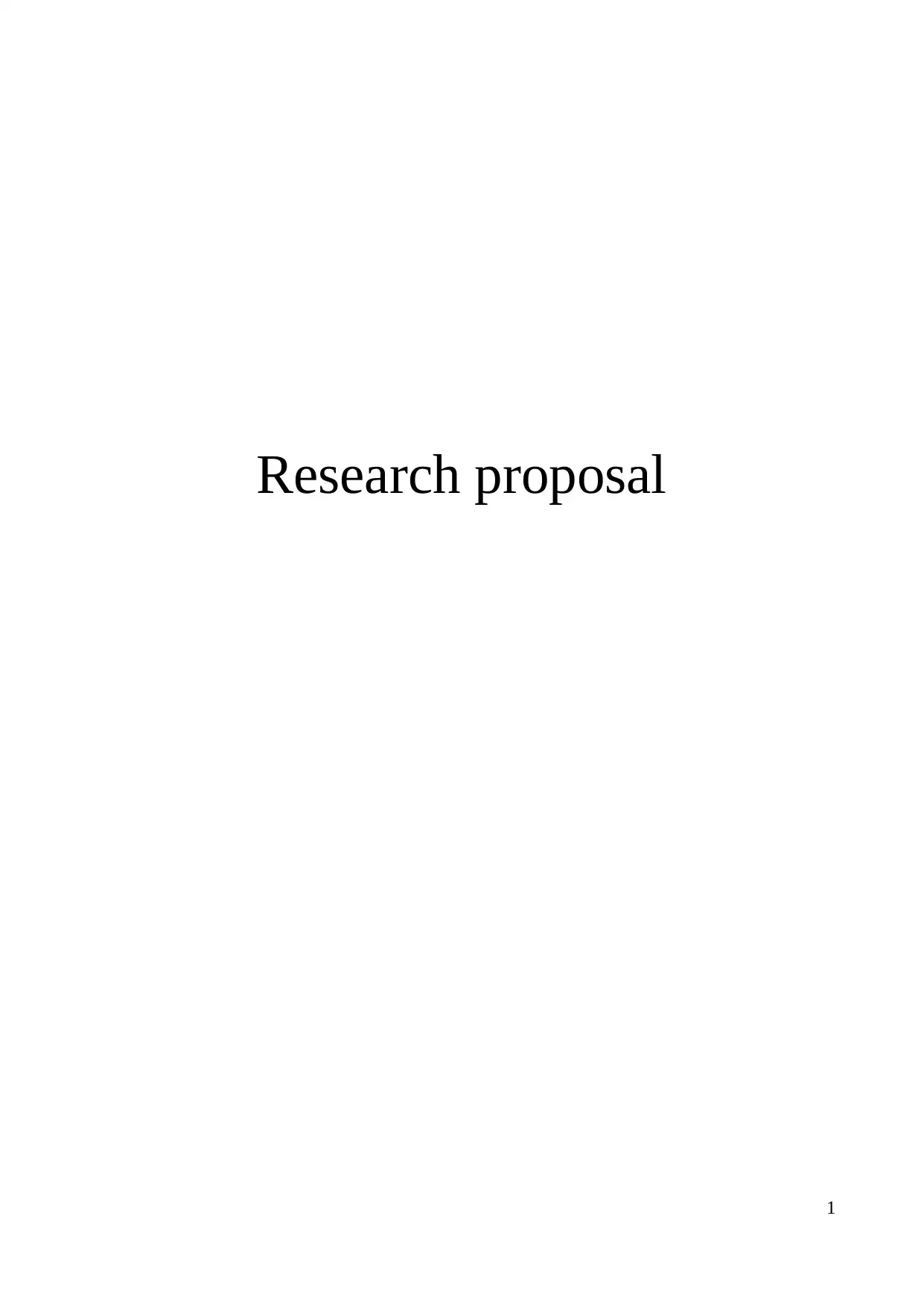
Research proposal
1
1
Paraphrase This Document
Need a fresh take? Get an instant paraphrase of this document with our AI Paraphraser
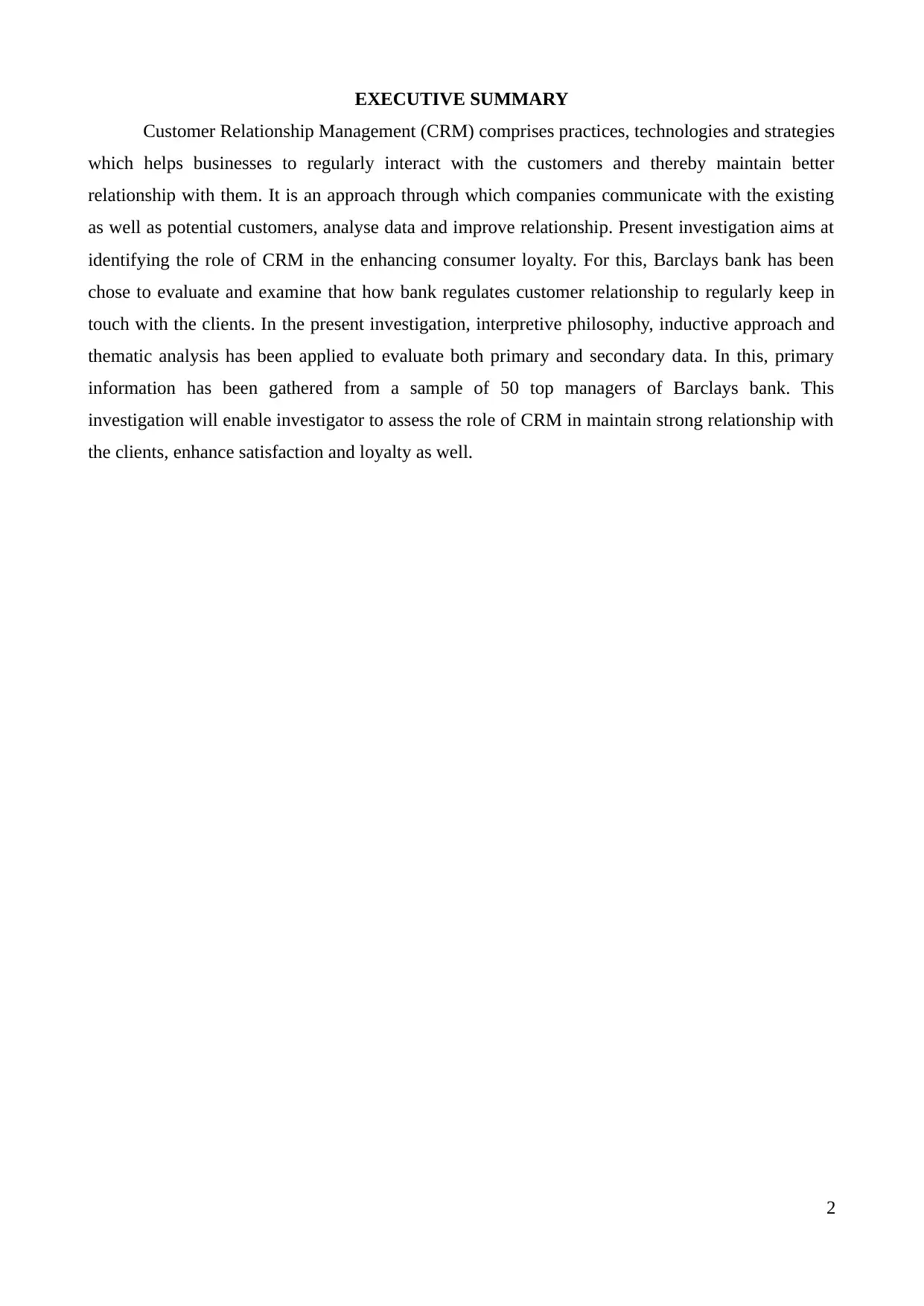
EXECUTIVE SUMMARY
Customer Relationship Management (CRM) comprises practices, technologies and strategies
which helps businesses to regularly interact with the customers and thereby maintain better
relationship with them. It is an approach through which companies communicate with the existing
as well as potential customers, analyse data and improve relationship. Present investigation aims at
identifying the role of CRM in the enhancing consumer loyalty. For this, Barclays bank has been
chose to evaluate and examine that how bank regulates customer relationship to regularly keep in
touch with the clients. In the present investigation, interpretive philosophy, inductive approach and
thematic analysis has been applied to evaluate both primary and secondary data. In this, primary
information has been gathered from a sample of 50 top managers of Barclays bank. This
investigation will enable investigator to assess the role of CRM in maintain strong relationship with
the clients, enhance satisfaction and loyalty as well.
2
Customer Relationship Management (CRM) comprises practices, technologies and strategies
which helps businesses to regularly interact with the customers and thereby maintain better
relationship with them. It is an approach through which companies communicate with the existing
as well as potential customers, analyse data and improve relationship. Present investigation aims at
identifying the role of CRM in the enhancing consumer loyalty. For this, Barclays bank has been
chose to evaluate and examine that how bank regulates customer relationship to regularly keep in
touch with the clients. In the present investigation, interpretive philosophy, inductive approach and
thematic analysis has been applied to evaluate both primary and secondary data. In this, primary
information has been gathered from a sample of 50 top managers of Barclays bank. This
investigation will enable investigator to assess the role of CRM in maintain strong relationship with
the clients, enhance satisfaction and loyalty as well.
2
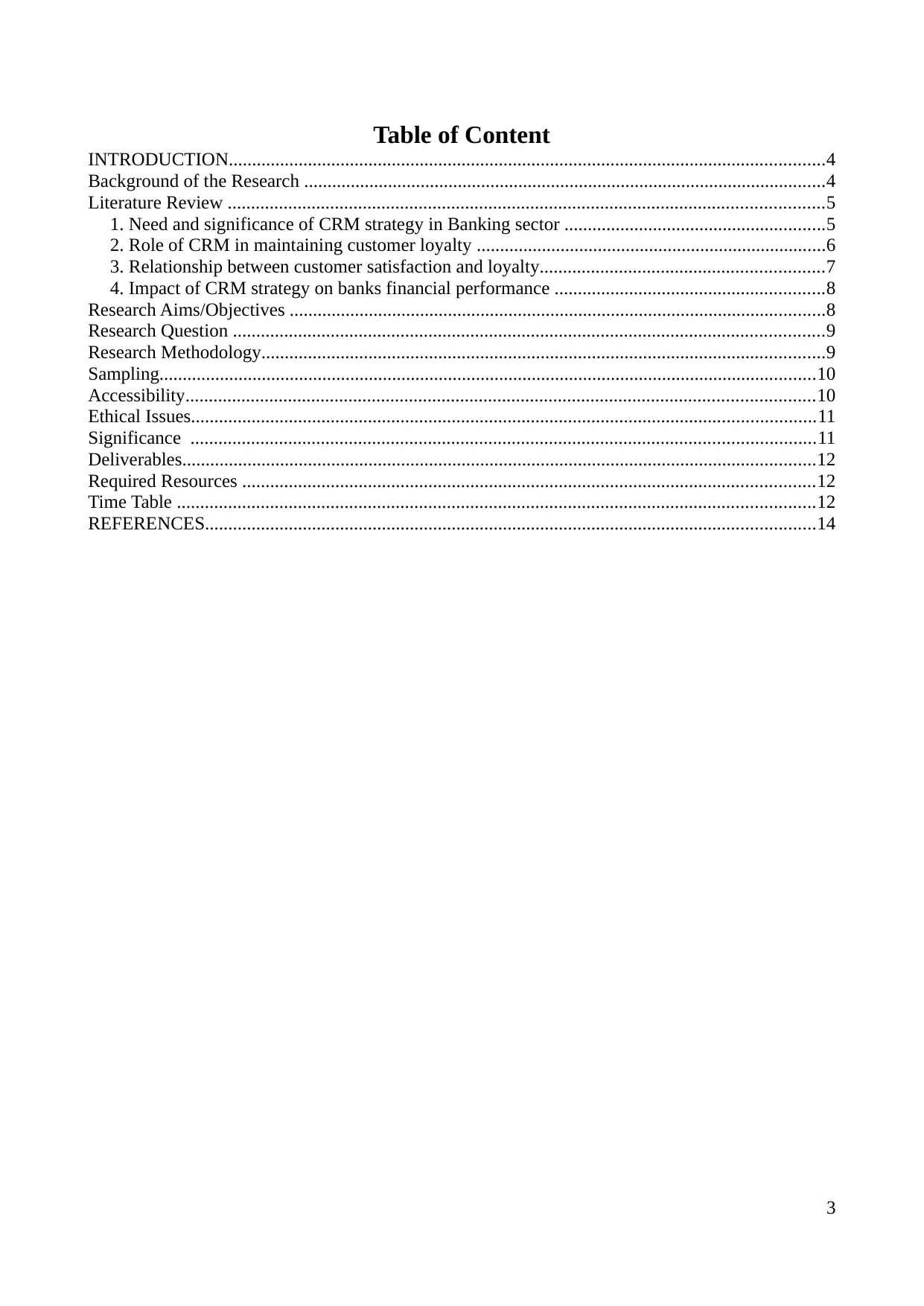
Table of Content
INTRODUCTION................................................................................................................................4
Background of the Research ................................................................................................................4
Literature Review ................................................................................................................................5
1. Need and significance of CRM strategy in Banking sector ........................................................5
2. Role of CRM in maintaining customer loyalty ...........................................................................6
3. Relationship between customer satisfaction and loyalty.............................................................7
4. Impact of CRM strategy on banks financial performance ..........................................................8
Research Aims/Objectives ...................................................................................................................8
Research Question ...............................................................................................................................9
Research Methodology.........................................................................................................................9
Sampling.............................................................................................................................................10
Accessibility.......................................................................................................................................10
Ethical Issues......................................................................................................................................11
Significance ......................................................................................................................................11
Deliverables........................................................................................................................................12
Required Resources ...........................................................................................................................12
Time Table .........................................................................................................................................12
REFERENCES...................................................................................................................................14
3
INTRODUCTION................................................................................................................................4
Background of the Research ................................................................................................................4
Literature Review ................................................................................................................................5
1. Need and significance of CRM strategy in Banking sector ........................................................5
2. Role of CRM in maintaining customer loyalty ...........................................................................6
3. Relationship between customer satisfaction and loyalty.............................................................7
4. Impact of CRM strategy on banks financial performance ..........................................................8
Research Aims/Objectives ...................................................................................................................8
Research Question ...............................................................................................................................9
Research Methodology.........................................................................................................................9
Sampling.............................................................................................................................................10
Accessibility.......................................................................................................................................10
Ethical Issues......................................................................................................................................11
Significance ......................................................................................................................................11
Deliverables........................................................................................................................................12
Required Resources ...........................................................................................................................12
Time Table .........................................................................................................................................12
REFERENCES...................................................................................................................................14
3
⊘ This is a preview!⊘
Do you want full access?
Subscribe today to unlock all pages.

Trusted by 1+ million students worldwide
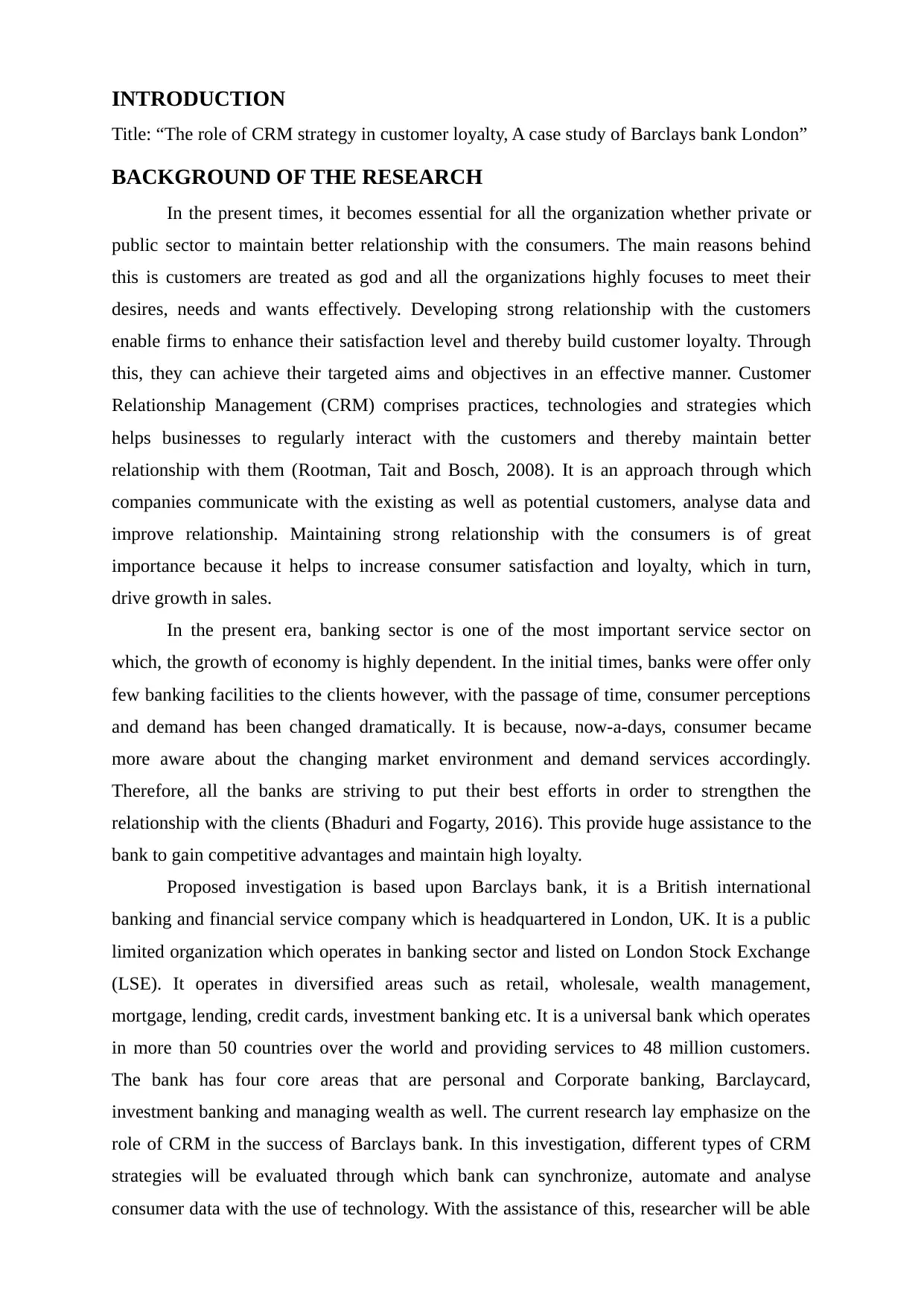
INTRODUCTION
Title: “The role of CRM strategy in customer loyalty, A case study of Barclays bank London”
BACKGROUND OF THE RESEARCH
In the present times, it becomes essential for all the organization whether private or
public sector to maintain better relationship with the consumers. The main reasons behind
this is customers are treated as god and all the organizations highly focuses to meet their
desires, needs and wants effectively. Developing strong relationship with the customers
enable firms to enhance their satisfaction level and thereby build customer loyalty. Through
this, they can achieve their targeted aims and objectives in an effective manner. Customer
Relationship Management (CRM) comprises practices, technologies and strategies which
helps businesses to regularly interact with the customers and thereby maintain better
relationship with them (Rootman, Tait and Bosch, 2008). It is an approach through which
companies communicate with the existing as well as potential customers, analyse data and
improve relationship. Maintaining strong relationship with the consumers is of great
importance because it helps to increase consumer satisfaction and loyalty, which in turn,
drive growth in sales.
In the present era, banking sector is one of the most important service sector on
which, the growth of economy is highly dependent. In the initial times, banks were offer only
few banking facilities to the clients however, with the passage of time, consumer perceptions
and demand has been changed dramatically. It is because, now-a-days, consumer became
more aware about the changing market environment and demand services accordingly.
Therefore, all the banks are striving to put their best efforts in order to strengthen the
relationship with the clients (Bhaduri and Fogarty, 2016). This provide huge assistance to the
bank to gain competitive advantages and maintain high loyalty.
Proposed investigation is based upon Barclays bank, it is a British international
banking and financial service company which is headquartered in London, UK. It is a public
limited organization which operates in banking sector and listed on London Stock Exchange
(LSE). It operates in diversified areas such as retail, wholesale, wealth management,
mortgage, lending, credit cards, investment banking etc. It is a universal bank which operates
in more than 50 countries over the world and providing services to 48 million customers.
The bank has four core areas that are personal and Corporate banking, Barclaycard,
investment banking and managing wealth as well. The current research lay emphasize on the
role of CRM in the success of Barclays bank. In this investigation, different types of CRM
strategies will be evaluated through which bank can synchronize, automate and analyse
consumer data with the use of technology. With the assistance of this, researcher will be able
Title: “The role of CRM strategy in customer loyalty, A case study of Barclays bank London”
BACKGROUND OF THE RESEARCH
In the present times, it becomes essential for all the organization whether private or
public sector to maintain better relationship with the consumers. The main reasons behind
this is customers are treated as god and all the organizations highly focuses to meet their
desires, needs and wants effectively. Developing strong relationship with the customers
enable firms to enhance their satisfaction level and thereby build customer loyalty. Through
this, they can achieve their targeted aims and objectives in an effective manner. Customer
Relationship Management (CRM) comprises practices, technologies and strategies which
helps businesses to regularly interact with the customers and thereby maintain better
relationship with them (Rootman, Tait and Bosch, 2008). It is an approach through which
companies communicate with the existing as well as potential customers, analyse data and
improve relationship. Maintaining strong relationship with the consumers is of great
importance because it helps to increase consumer satisfaction and loyalty, which in turn,
drive growth in sales.
In the present era, banking sector is one of the most important service sector on
which, the growth of economy is highly dependent. In the initial times, banks were offer only
few banking facilities to the clients however, with the passage of time, consumer perceptions
and demand has been changed dramatically. It is because, now-a-days, consumer became
more aware about the changing market environment and demand services accordingly.
Therefore, all the banks are striving to put their best efforts in order to strengthen the
relationship with the clients (Bhaduri and Fogarty, 2016). This provide huge assistance to the
bank to gain competitive advantages and maintain high loyalty.
Proposed investigation is based upon Barclays bank, it is a British international
banking and financial service company which is headquartered in London, UK. It is a public
limited organization which operates in banking sector and listed on London Stock Exchange
(LSE). It operates in diversified areas such as retail, wholesale, wealth management,
mortgage, lending, credit cards, investment banking etc. It is a universal bank which operates
in more than 50 countries over the world and providing services to 48 million customers.
The bank has four core areas that are personal and Corporate banking, Barclaycard,
investment banking and managing wealth as well. The current research lay emphasize on the
role of CRM in the success of Barclays bank. In this investigation, different types of CRM
strategies will be evaluated through which bank can synchronize, automate and analyse
consumer data with the use of technology. With the assistance of this, researcher will be able
Paraphrase This Document
Need a fresh take? Get an instant paraphrase of this document with our AI Paraphraser
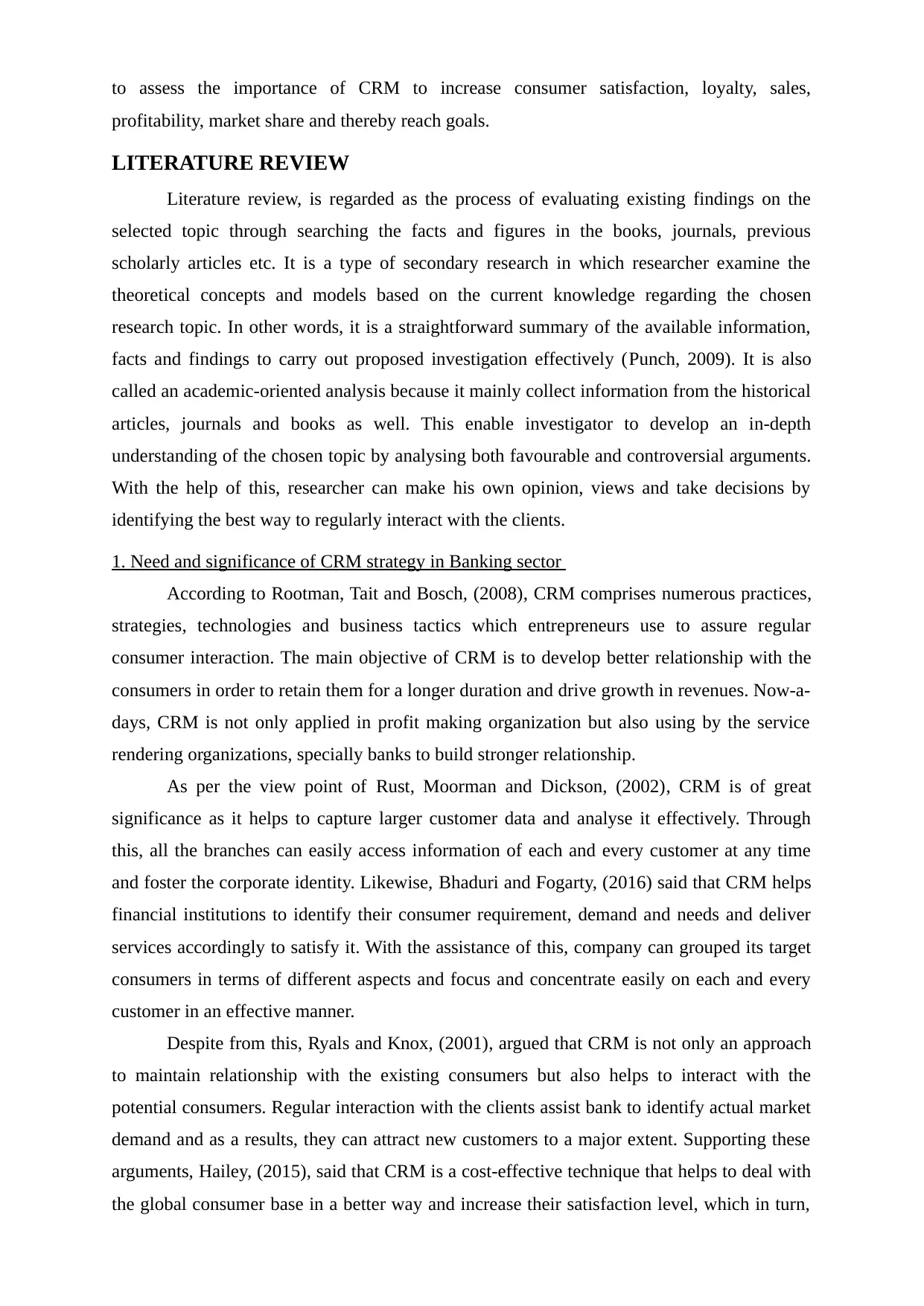
to assess the importance of CRM to increase consumer satisfaction, loyalty, sales,
profitability, market share and thereby reach goals.
LITERATURE REVIEW
Literature review, is regarded as the process of evaluating existing findings on the
selected topic through searching the facts and figures in the books, journals, previous
scholarly articles etc. It is a type of secondary research in which researcher examine the
theoretical concepts and models based on the current knowledge regarding the chosen
research topic. In other words, it is a straightforward summary of the available information,
facts and findings to carry out proposed investigation effectively (Punch, 2009). It is also
called an academic-oriented analysis because it mainly collect information from the historical
articles, journals and books as well. This enable investigator to develop an in-depth
understanding of the chosen topic by analysing both favourable and controversial arguments.
With the help of this, researcher can make his own opinion, views and take decisions by
identifying the best way to regularly interact with the clients.
1. Need and significance of CRM strategy in Banking sector
According to Rootman, Tait and Bosch, (2008), CRM comprises numerous practices,
strategies, technologies and business tactics which entrepreneurs use to assure regular
consumer interaction. The main objective of CRM is to develop better relationship with the
consumers in order to retain them for a longer duration and drive growth in revenues. Now-a-
days, CRM is not only applied in profit making organization but also using by the service
rendering organizations, specially banks to build stronger relationship.
As per the view point of Rust, Moorman and Dickson, (2002), CRM is of great
significance as it helps to capture larger customer data and analyse it effectively. Through
this, all the branches can easily access information of each and every customer at any time
and foster the corporate identity. Likewise, Bhaduri and Fogarty, (2016) said that CRM helps
financial institutions to identify their consumer requirement, demand and needs and deliver
services accordingly to satisfy it. With the assistance of this, company can grouped its target
consumers in terms of different aspects and focus and concentrate easily on each and every
customer in an effective manner.
Despite from this, Ryals and Knox, (2001), argued that CRM is not only an approach
to maintain relationship with the existing consumers but also helps to interact with the
potential consumers. Regular interaction with the clients assist bank to identify actual market
demand and as a results, they can attract new customers to a major extent. Supporting these
arguments, Hailey, (2015), said that CRM is a cost-effective technique that helps to deal with
the global consumer base in a better way and increase their satisfaction level, which in turn,
profitability, market share and thereby reach goals.
LITERATURE REVIEW
Literature review, is regarded as the process of evaluating existing findings on the
selected topic through searching the facts and figures in the books, journals, previous
scholarly articles etc. It is a type of secondary research in which researcher examine the
theoretical concepts and models based on the current knowledge regarding the chosen
research topic. In other words, it is a straightforward summary of the available information,
facts and findings to carry out proposed investigation effectively (Punch, 2009). It is also
called an academic-oriented analysis because it mainly collect information from the historical
articles, journals and books as well. This enable investigator to develop an in-depth
understanding of the chosen topic by analysing both favourable and controversial arguments.
With the help of this, researcher can make his own opinion, views and take decisions by
identifying the best way to regularly interact with the clients.
1. Need and significance of CRM strategy in Banking sector
According to Rootman, Tait and Bosch, (2008), CRM comprises numerous practices,
strategies, technologies and business tactics which entrepreneurs use to assure regular
consumer interaction. The main objective of CRM is to develop better relationship with the
consumers in order to retain them for a longer duration and drive growth in revenues. Now-a-
days, CRM is not only applied in profit making organization but also using by the service
rendering organizations, specially banks to build stronger relationship.
As per the view point of Rust, Moorman and Dickson, (2002), CRM is of great
significance as it helps to capture larger customer data and analyse it effectively. Through
this, all the branches can easily access information of each and every customer at any time
and foster the corporate identity. Likewise, Bhaduri and Fogarty, (2016) said that CRM helps
financial institutions to identify their consumer requirement, demand and needs and deliver
services accordingly to satisfy it. With the assistance of this, company can grouped its target
consumers in terms of different aspects and focus and concentrate easily on each and every
customer in an effective manner.
Despite from this, Ryals and Knox, (2001), argued that CRM is not only an approach
to maintain relationship with the existing consumers but also helps to interact with the
potential consumers. Regular interaction with the clients assist bank to identify actual market
demand and as a results, they can attract new customers to a major extent. Supporting these
arguments, Hailey, (2015), said that CRM is a cost-effective technique that helps to deal with
the global consumer base in a better way and increase their satisfaction level, which in turn,
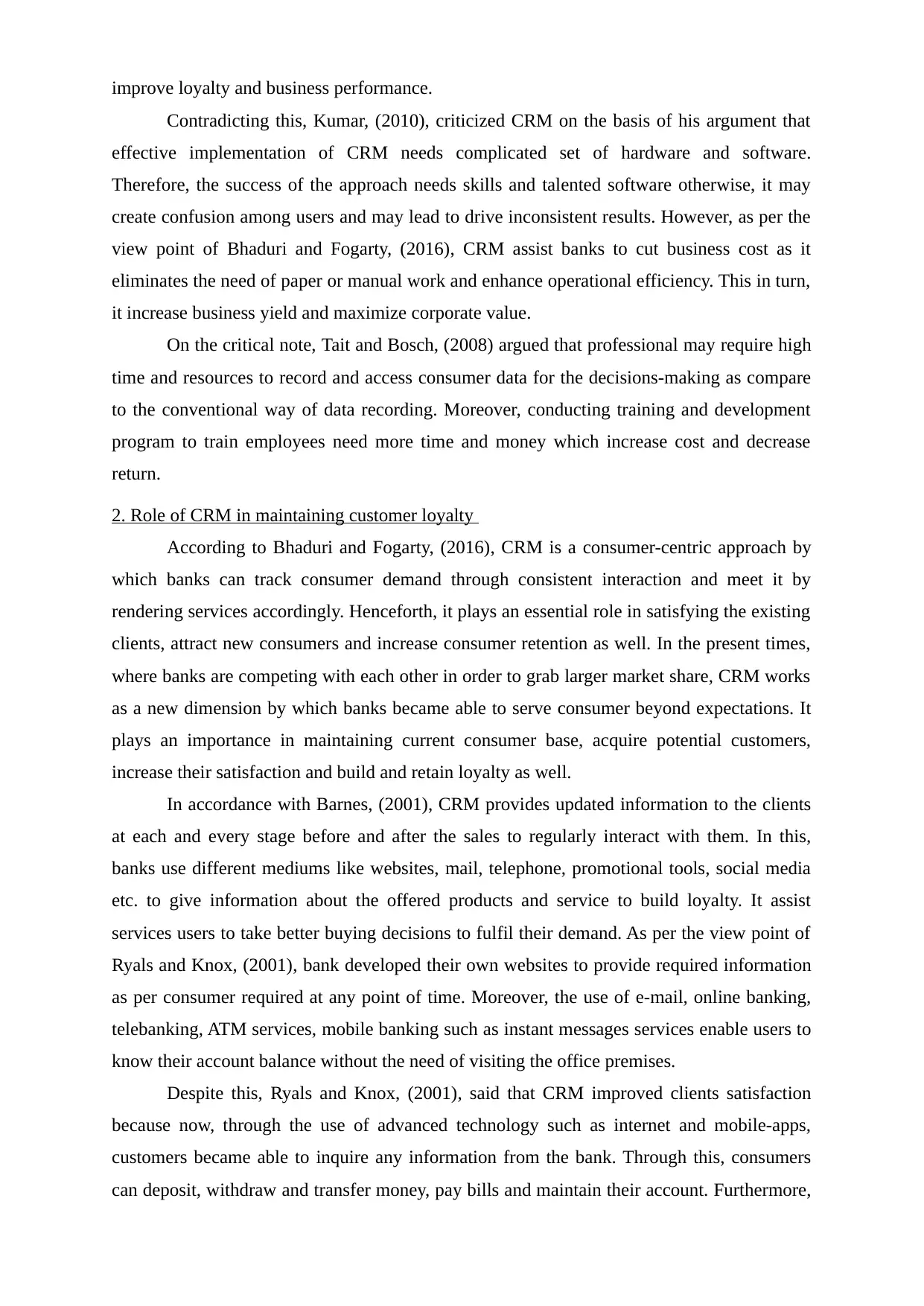
improve loyalty and business performance.
Contradicting this, Kumar, (2010), criticized CRM on the basis of his argument that
effective implementation of CRM needs complicated set of hardware and software.
Therefore, the success of the approach needs skills and talented software otherwise, it may
create confusion among users and may lead to drive inconsistent results. However, as per the
view point of Bhaduri and Fogarty, (2016), CRM assist banks to cut business cost as it
eliminates the need of paper or manual work and enhance operational efficiency. This in turn,
it increase business yield and maximize corporate value.
On the critical note, Tait and Bosch, (2008) argued that professional may require high
time and resources to record and access consumer data for the decisions-making as compare
to the conventional way of data recording. Moreover, conducting training and development
program to train employees need more time and money which increase cost and decrease
return.
2. Role of CRM in maintaining customer loyalty
According to Bhaduri and Fogarty, (2016), CRM is a consumer-centric approach by
which banks can track consumer demand through consistent interaction and meet it by
rendering services accordingly. Henceforth, it plays an essential role in satisfying the existing
clients, attract new consumers and increase consumer retention as well. In the present times,
where banks are competing with each other in order to grab larger market share, CRM works
as a new dimension by which banks became able to serve consumer beyond expectations. It
plays an importance in maintaining current consumer base, acquire potential customers,
increase their satisfaction and build and retain loyalty as well.
In accordance with Barnes, (2001), CRM provides updated information to the clients
at each and every stage before and after the sales to regularly interact with them. In this,
banks use different mediums like websites, mail, telephone, promotional tools, social media
etc. to give information about the offered products and service to build loyalty. It assist
services users to take better buying decisions to fulfil their demand. As per the view point of
Ryals and Knox, (2001), bank developed their own websites to provide required information
as per consumer required at any point of time. Moreover, the use of e-mail, online banking,
telebanking, ATM services, mobile banking such as instant messages services enable users to
know their account balance without the need of visiting the office premises.
Despite this, Ryals and Knox, (2001), said that CRM improved clients satisfaction
because now, through the use of advanced technology such as internet and mobile-apps,
customers became able to inquire any information from the bank. Through this, consumers
can deposit, withdraw and transfer money, pay bills and maintain their account. Furthermore,
Contradicting this, Kumar, (2010), criticized CRM on the basis of his argument that
effective implementation of CRM needs complicated set of hardware and software.
Therefore, the success of the approach needs skills and talented software otherwise, it may
create confusion among users and may lead to drive inconsistent results. However, as per the
view point of Bhaduri and Fogarty, (2016), CRM assist banks to cut business cost as it
eliminates the need of paper or manual work and enhance operational efficiency. This in turn,
it increase business yield and maximize corporate value.
On the critical note, Tait and Bosch, (2008) argued that professional may require high
time and resources to record and access consumer data for the decisions-making as compare
to the conventional way of data recording. Moreover, conducting training and development
program to train employees need more time and money which increase cost and decrease
return.
2. Role of CRM in maintaining customer loyalty
According to Bhaduri and Fogarty, (2016), CRM is a consumer-centric approach by
which banks can track consumer demand through consistent interaction and meet it by
rendering services accordingly. Henceforth, it plays an essential role in satisfying the existing
clients, attract new consumers and increase consumer retention as well. In the present times,
where banks are competing with each other in order to grab larger market share, CRM works
as a new dimension by which banks became able to serve consumer beyond expectations. It
plays an importance in maintaining current consumer base, acquire potential customers,
increase their satisfaction and build and retain loyalty as well.
In accordance with Barnes, (2001), CRM provides updated information to the clients
at each and every stage before and after the sales to regularly interact with them. In this,
banks use different mediums like websites, mail, telephone, promotional tools, social media
etc. to give information about the offered products and service to build loyalty. It assist
services users to take better buying decisions to fulfil their demand. As per the view point of
Ryals and Knox, (2001), bank developed their own websites to provide required information
as per consumer required at any point of time. Moreover, the use of e-mail, online banking,
telebanking, ATM services, mobile banking such as instant messages services enable users to
know their account balance without the need of visiting the office premises.
Despite this, Ryals and Knox, (2001), said that CRM improved clients satisfaction
because now, through the use of advanced technology such as internet and mobile-apps,
customers became able to inquire any information from the bank. Through this, consumers
can deposit, withdraw and transfer money, pay bills and maintain their account. Furthermore,
⊘ This is a preview!⊘
Do you want full access?
Subscribe today to unlock all pages.

Trusted by 1+ million students worldwide
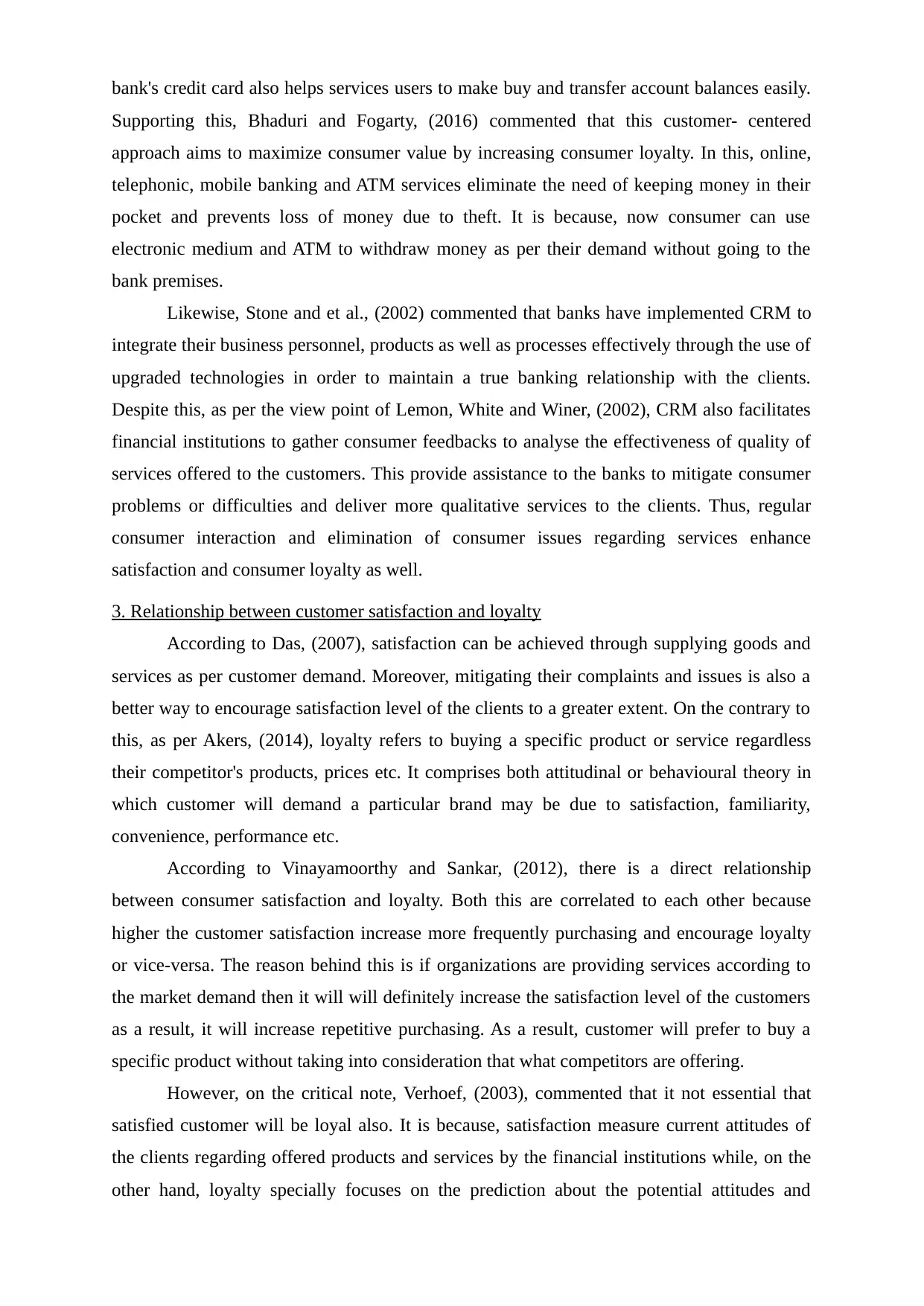
bank's credit card also helps services users to make buy and transfer account balances easily.
Supporting this, Bhaduri and Fogarty, (2016) commented that this customer- centered
approach aims to maximize consumer value by increasing consumer loyalty. In this, online,
telephonic, mobile banking and ATM services eliminate the need of keeping money in their
pocket and prevents loss of money due to theft. It is because, now consumer can use
electronic medium and ATM to withdraw money as per their demand without going to the
bank premises.
Likewise, Stone and et al., (2002) commented that banks have implemented CRM to
integrate their business personnel, products as well as processes effectively through the use of
upgraded technologies in order to maintain a true banking relationship with the clients.
Despite this, as per the view point of Lemon, White and Winer, (2002), CRM also facilitates
financial institutions to gather consumer feedbacks to analyse the effectiveness of quality of
services offered to the customers. This provide assistance to the banks to mitigate consumer
problems or difficulties and deliver more qualitative services to the clients. Thus, regular
consumer interaction and elimination of consumer issues regarding services enhance
satisfaction and consumer loyalty as well.
3. Relationship between customer satisfaction and loyalty
According to Das, (2007), satisfaction can be achieved through supplying goods and
services as per customer demand. Moreover, mitigating their complaints and issues is also a
better way to encourage satisfaction level of the clients to a greater extent. On the contrary to
this, as per Akers, (2014), loyalty refers to buying a specific product or service regardless
their competitor's products, prices etc. It comprises both attitudinal or behavioural theory in
which customer will demand a particular brand may be due to satisfaction, familiarity,
convenience, performance etc.
According to Vinayamoorthy and Sankar, (2012), there is a direct relationship
between consumer satisfaction and loyalty. Both this are correlated to each other because
higher the customer satisfaction increase more frequently purchasing and encourage loyalty
or vice-versa. The reason behind this is if organizations are providing services according to
the market demand then it will will definitely increase the satisfaction level of the customers
as a result, it will increase repetitive purchasing. As a result, customer will prefer to buy a
specific product without taking into consideration that what competitors are offering.
However, on the critical note, Verhoef, (2003), commented that it not essential that
satisfied customer will be loyal also. It is because, satisfaction measure current attitudes of
the clients regarding offered products and services by the financial institutions while, on the
other hand, loyalty specially focuses on the prediction about the potential attitudes and
Supporting this, Bhaduri and Fogarty, (2016) commented that this customer- centered
approach aims to maximize consumer value by increasing consumer loyalty. In this, online,
telephonic, mobile banking and ATM services eliminate the need of keeping money in their
pocket and prevents loss of money due to theft. It is because, now consumer can use
electronic medium and ATM to withdraw money as per their demand without going to the
bank premises.
Likewise, Stone and et al., (2002) commented that banks have implemented CRM to
integrate their business personnel, products as well as processes effectively through the use of
upgraded technologies in order to maintain a true banking relationship with the clients.
Despite this, as per the view point of Lemon, White and Winer, (2002), CRM also facilitates
financial institutions to gather consumer feedbacks to analyse the effectiveness of quality of
services offered to the customers. This provide assistance to the banks to mitigate consumer
problems or difficulties and deliver more qualitative services to the clients. Thus, regular
consumer interaction and elimination of consumer issues regarding services enhance
satisfaction and consumer loyalty as well.
3. Relationship between customer satisfaction and loyalty
According to Das, (2007), satisfaction can be achieved through supplying goods and
services as per customer demand. Moreover, mitigating their complaints and issues is also a
better way to encourage satisfaction level of the clients to a greater extent. On the contrary to
this, as per Akers, (2014), loyalty refers to buying a specific product or service regardless
their competitor's products, prices etc. It comprises both attitudinal or behavioural theory in
which customer will demand a particular brand may be due to satisfaction, familiarity,
convenience, performance etc.
According to Vinayamoorthy and Sankar, (2012), there is a direct relationship
between consumer satisfaction and loyalty. Both this are correlated to each other because
higher the customer satisfaction increase more frequently purchasing and encourage loyalty
or vice-versa. The reason behind this is if organizations are providing services according to
the market demand then it will will definitely increase the satisfaction level of the customers
as a result, it will increase repetitive purchasing. As a result, customer will prefer to buy a
specific product without taking into consideration that what competitors are offering.
However, on the critical note, Verhoef, (2003), commented that it not essential that
satisfied customer will be loyal also. It is because, satisfaction measure current attitudes of
the clients regarding offered products and services by the financial institutions while, on the
other hand, loyalty specially focuses on the prediction about the potential attitudes and
Paraphrase This Document
Need a fresh take? Get an instant paraphrase of this document with our AI Paraphraser
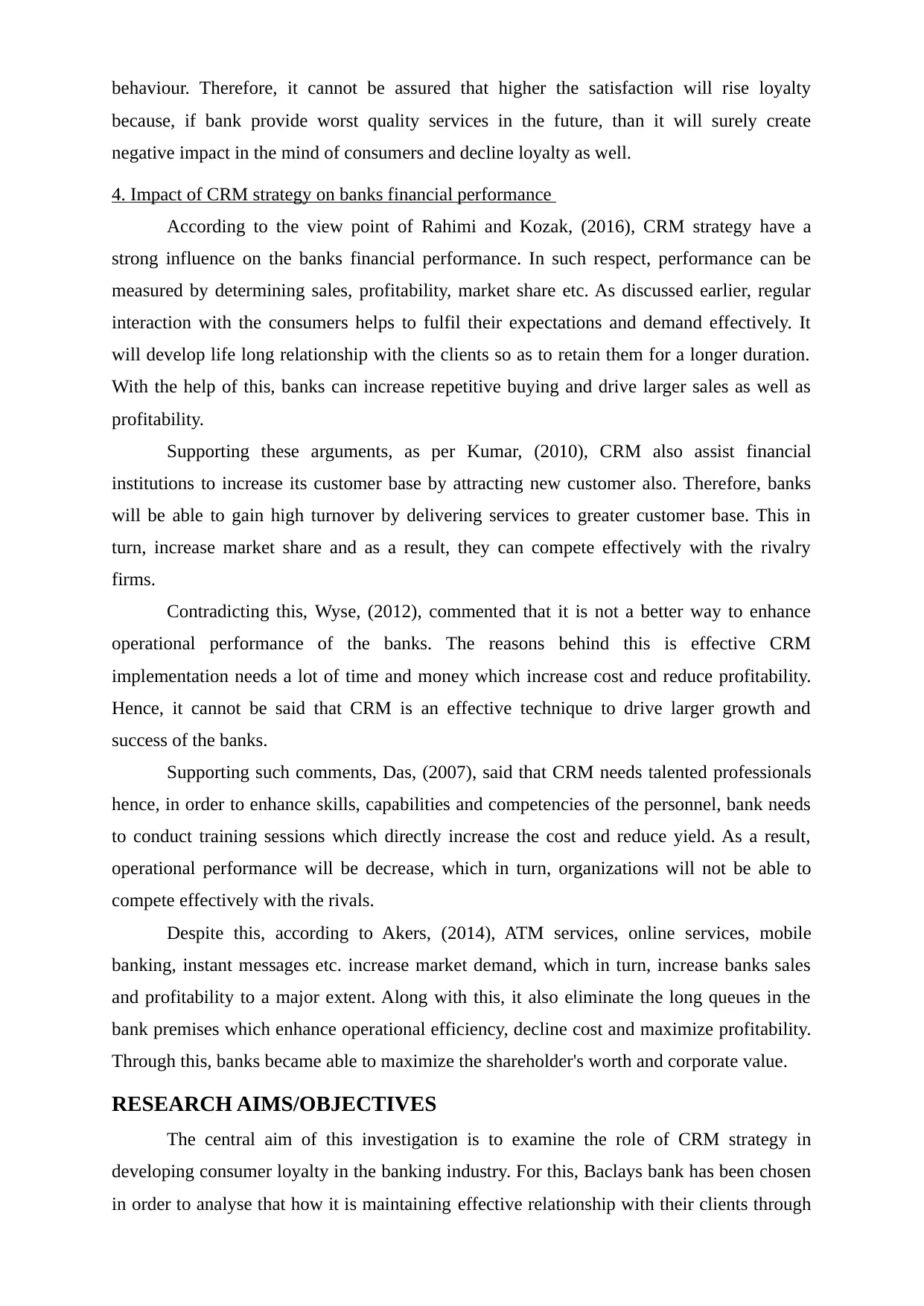
behaviour. Therefore, it cannot be assured that higher the satisfaction will rise loyalty
because, if bank provide worst quality services in the future, than it will surely create
negative impact in the mind of consumers and decline loyalty as well.
4. Impact of CRM strategy on banks financial performance
According to the view point of Rahimi and Kozak, (2016), CRM strategy have a
strong influence on the banks financial performance. In such respect, performance can be
measured by determining sales, profitability, market share etc. As discussed earlier, regular
interaction with the consumers helps to fulfil their expectations and demand effectively. It
will develop life long relationship with the clients so as to retain them for a longer duration.
With the help of this, banks can increase repetitive buying and drive larger sales as well as
profitability.
Supporting these arguments, as per Kumar, (2010), CRM also assist financial
institutions to increase its customer base by attracting new customer also. Therefore, banks
will be able to gain high turnover by delivering services to greater customer base. This in
turn, increase market share and as a result, they can compete effectively with the rivalry
firms.
Contradicting this, Wyse, (2012), commented that it is not a better way to enhance
operational performance of the banks. The reasons behind this is effective CRM
implementation needs a lot of time and money which increase cost and reduce profitability.
Hence, it cannot be said that CRM is an effective technique to drive larger growth and
success of the banks.
Supporting such comments, Das, (2007), said that CRM needs talented professionals
hence, in order to enhance skills, capabilities and competencies of the personnel, bank needs
to conduct training sessions which directly increase the cost and reduce yield. As a result,
operational performance will be decrease, which in turn, organizations will not be able to
compete effectively with the rivals.
Despite this, according to Akers, (2014), ATM services, online services, mobile
banking, instant messages etc. increase market demand, which in turn, increase banks sales
and profitability to a major extent. Along with this, it also eliminate the long queues in the
bank premises which enhance operational efficiency, decline cost and maximize profitability.
Through this, banks became able to maximize the shareholder's worth and corporate value.
RESEARCH AIMS/OBJECTIVES
The central aim of this investigation is to examine the role of CRM strategy in
developing consumer loyalty in the banking industry. For this, Baclays bank has been chosen
in order to analyse that how it is maintaining effective relationship with their clients through
because, if bank provide worst quality services in the future, than it will surely create
negative impact in the mind of consumers and decline loyalty as well.
4. Impact of CRM strategy on banks financial performance
According to the view point of Rahimi and Kozak, (2016), CRM strategy have a
strong influence on the banks financial performance. In such respect, performance can be
measured by determining sales, profitability, market share etc. As discussed earlier, regular
interaction with the consumers helps to fulfil their expectations and demand effectively. It
will develop life long relationship with the clients so as to retain them for a longer duration.
With the help of this, banks can increase repetitive buying and drive larger sales as well as
profitability.
Supporting these arguments, as per Kumar, (2010), CRM also assist financial
institutions to increase its customer base by attracting new customer also. Therefore, banks
will be able to gain high turnover by delivering services to greater customer base. This in
turn, increase market share and as a result, they can compete effectively with the rivalry
firms.
Contradicting this, Wyse, (2012), commented that it is not a better way to enhance
operational performance of the banks. The reasons behind this is effective CRM
implementation needs a lot of time and money which increase cost and reduce profitability.
Hence, it cannot be said that CRM is an effective technique to drive larger growth and
success of the banks.
Supporting such comments, Das, (2007), said that CRM needs talented professionals
hence, in order to enhance skills, capabilities and competencies of the personnel, bank needs
to conduct training sessions which directly increase the cost and reduce yield. As a result,
operational performance will be decrease, which in turn, organizations will not be able to
compete effectively with the rivals.
Despite this, according to Akers, (2014), ATM services, online services, mobile
banking, instant messages etc. increase market demand, which in turn, increase banks sales
and profitability to a major extent. Along with this, it also eliminate the long queues in the
bank premises which enhance operational efficiency, decline cost and maximize profitability.
Through this, banks became able to maximize the shareholder's worth and corporate value.
RESEARCH AIMS/OBJECTIVES
The central aim of this investigation is to examine the role of CRM strategy in
developing consumer loyalty in the banking industry. For this, Baclays bank has been chosen
in order to analyse that how it is maintaining effective relationship with their clients through
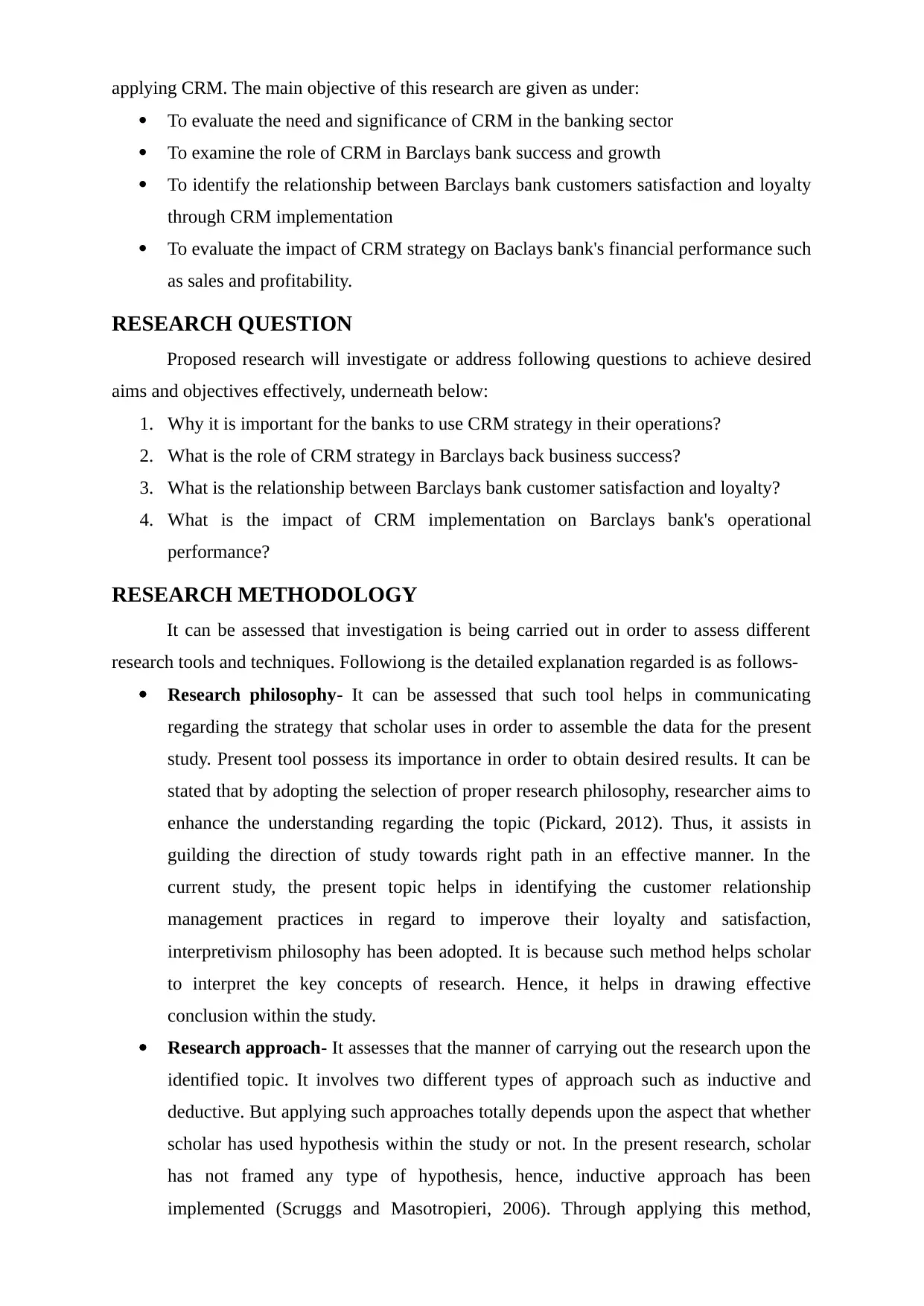
applying CRM. The main objective of this research are given as under:
To evaluate the need and significance of CRM in the banking sector
To examine the role of CRM in Barclays bank success and growth
To identify the relationship between Barclays bank customers satisfaction and loyalty
through CRM implementation
To evaluate the impact of CRM strategy on Baclays bank's financial performance such
as sales and profitability.
RESEARCH QUESTION
Proposed research will investigate or address following questions to achieve desired
aims and objectives effectively, underneath below:
1. Why it is important for the banks to use CRM strategy in their operations?
2. What is the role of CRM strategy in Barclays back business success?
3. What is the relationship between Barclays bank customer satisfaction and loyalty?
4. What is the impact of CRM implementation on Barclays bank's operational
performance?
RESEARCH METHODOLOGY
It can be assessed that investigation is being carried out in order to assess different
research tools and techniques. Followiong is the detailed explanation regarded is as follows-
Research philosophy- It can be assessed that such tool helps in communicating
regarding the strategy that scholar uses in order to assemble the data for the present
study. Present tool possess its importance in order to obtain desired results. It can be
stated that by adopting the selection of proper research philosophy, researcher aims to
enhance the understanding regarding the topic (Pickard, 2012). Thus, it assists in
guilding the direction of study towards right path in an effective manner. In the
current study, the present topic helps in identifying the customer relationship
management practices in regard to imperove their loyalty and satisfaction,
interpretivism philosophy has been adopted. It is because such method helps scholar
to interpret the key concepts of research. Hence, it helps in drawing effective
conclusion within the study.
Research approach- It assesses that the manner of carrying out the research upon the
identified topic. It involves two different types of approach such as inductive and
deductive. But applying such approaches totally depends upon the aspect that whether
scholar has used hypothesis within the study or not. In the present research, scholar
has not framed any type of hypothesis, hence, inductive approach has been
implemented (Scruggs and Masotropieri, 2006). Through applying this method,
To evaluate the need and significance of CRM in the banking sector
To examine the role of CRM in Barclays bank success and growth
To identify the relationship between Barclays bank customers satisfaction and loyalty
through CRM implementation
To evaluate the impact of CRM strategy on Baclays bank's financial performance such
as sales and profitability.
RESEARCH QUESTION
Proposed research will investigate or address following questions to achieve desired
aims and objectives effectively, underneath below:
1. Why it is important for the banks to use CRM strategy in their operations?
2. What is the role of CRM strategy in Barclays back business success?
3. What is the relationship between Barclays bank customer satisfaction and loyalty?
4. What is the impact of CRM implementation on Barclays bank's operational
performance?
RESEARCH METHODOLOGY
It can be assessed that investigation is being carried out in order to assess different
research tools and techniques. Followiong is the detailed explanation regarded is as follows-
Research philosophy- It can be assessed that such tool helps in communicating
regarding the strategy that scholar uses in order to assemble the data for the present
study. Present tool possess its importance in order to obtain desired results. It can be
stated that by adopting the selection of proper research philosophy, researcher aims to
enhance the understanding regarding the topic (Pickard, 2012). Thus, it assists in
guilding the direction of study towards right path in an effective manner. In the
current study, the present topic helps in identifying the customer relationship
management practices in regard to imperove their loyalty and satisfaction,
interpretivism philosophy has been adopted. It is because such method helps scholar
to interpret the key concepts of research. Hence, it helps in drawing effective
conclusion within the study.
Research approach- It assesses that the manner of carrying out the research upon the
identified topic. It involves two different types of approach such as inductive and
deductive. But applying such approaches totally depends upon the aspect that whether
scholar has used hypothesis within the study or not. In the present research, scholar
has not framed any type of hypothesis, hence, inductive approach has been
implemented (Scruggs and Masotropieri, 2006). Through applying this method,
⊘ This is a preview!⊘
Do you want full access?
Subscribe today to unlock all pages.

Trusted by 1+ million students worldwide
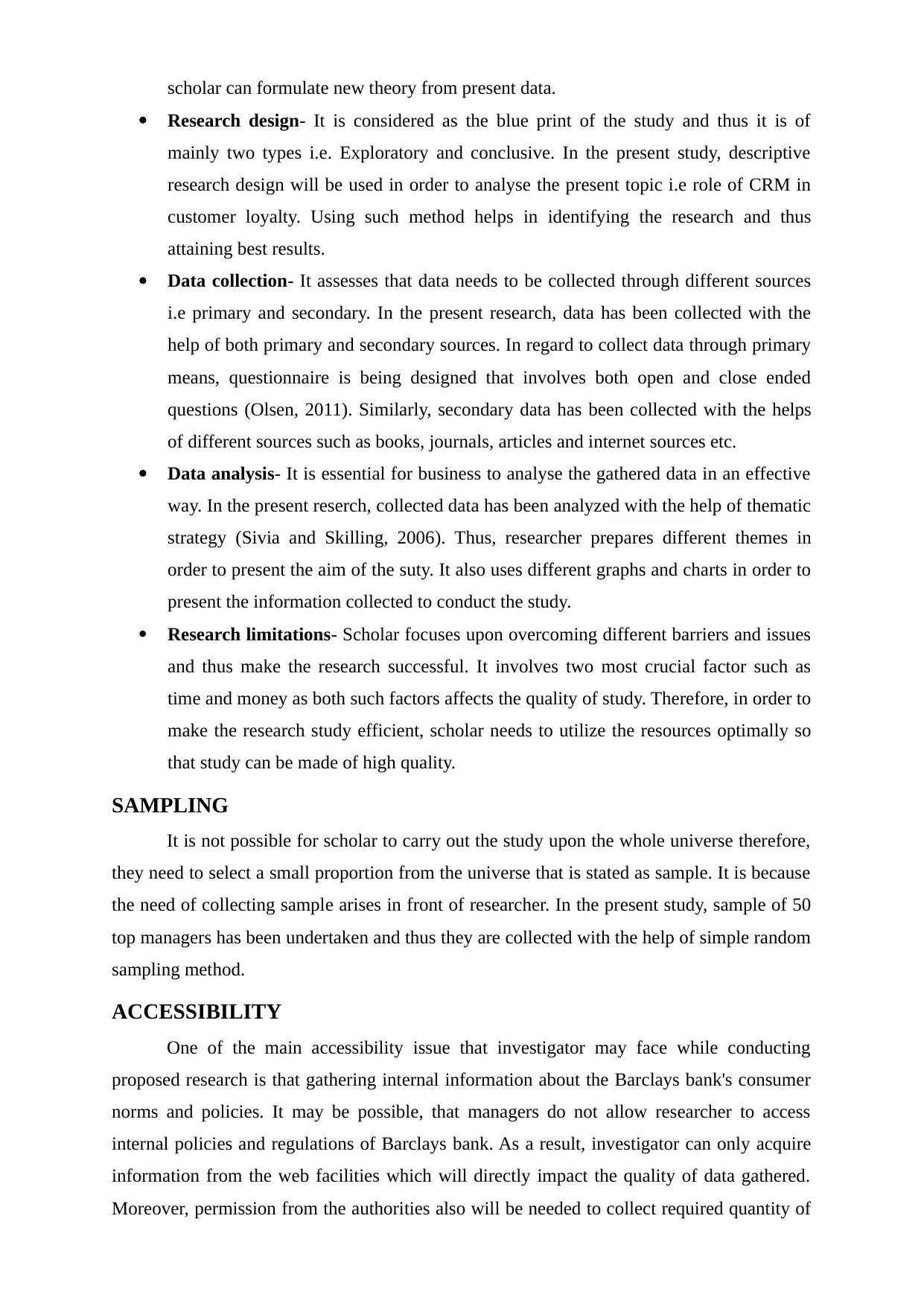
scholar can formulate new theory from present data.
Research design- It is considered as the blue print of the study and thus it is of
mainly two types i.e. Exploratory and conclusive. In the present study, descriptive
research design will be used in order to analyse the present topic i.e role of CRM in
customer loyalty. Using such method helps in identifying the research and thus
attaining best results.
Data collection- It assesses that data needs to be collected through different sources
i.e primary and secondary. In the present research, data has been collected with the
help of both primary and secondary sources. In regard to collect data through primary
means, questionnaire is being designed that involves both open and close ended
questions (Olsen, 2011). Similarly, secondary data has been collected with the helps
of different sources such as books, journals, articles and internet sources etc.
Data analysis- It is essential for business to analyse the gathered data in an effective
way. In the present reserch, collected data has been analyzed with the help of thematic
strategy (Sivia and Skilling, 2006). Thus, researcher prepares different themes in
order to present the aim of the suty. It also uses different graphs and charts in order to
present the information collected to conduct the study.
Research limitations- Scholar focuses upon overcoming different barriers and issues
and thus make the research successful. It involves two most crucial factor such as
time and money as both such factors affects the quality of study. Therefore, in order to
make the research study efficient, scholar needs to utilize the resources optimally so
that study can be made of high quality.
SAMPLING
It is not possible for scholar to carry out the study upon the whole universe therefore,
they need to select a small proportion from the universe that is stated as sample. It is because
the need of collecting sample arises in front of researcher. In the present study, sample of 50
top managers has been undertaken and thus they are collected with the help of simple random
sampling method.
ACCESSIBILITY
One of the main accessibility issue that investigator may face while conducting
proposed research is that gathering internal information about the Barclays bank's consumer
norms and policies. It may be possible, that managers do not allow researcher to access
internal policies and regulations of Barclays bank. As a result, investigator can only acquire
information from the web facilities which will directly impact the quality of data gathered.
Moreover, permission from the authorities also will be needed to collect required quantity of
Research design- It is considered as the blue print of the study and thus it is of
mainly two types i.e. Exploratory and conclusive. In the present study, descriptive
research design will be used in order to analyse the present topic i.e role of CRM in
customer loyalty. Using such method helps in identifying the research and thus
attaining best results.
Data collection- It assesses that data needs to be collected through different sources
i.e primary and secondary. In the present research, data has been collected with the
help of both primary and secondary sources. In regard to collect data through primary
means, questionnaire is being designed that involves both open and close ended
questions (Olsen, 2011). Similarly, secondary data has been collected with the helps
of different sources such as books, journals, articles and internet sources etc.
Data analysis- It is essential for business to analyse the gathered data in an effective
way. In the present reserch, collected data has been analyzed with the help of thematic
strategy (Sivia and Skilling, 2006). Thus, researcher prepares different themes in
order to present the aim of the suty. It also uses different graphs and charts in order to
present the information collected to conduct the study.
Research limitations- Scholar focuses upon overcoming different barriers and issues
and thus make the research successful. It involves two most crucial factor such as
time and money as both such factors affects the quality of study. Therefore, in order to
make the research study efficient, scholar needs to utilize the resources optimally so
that study can be made of high quality.
SAMPLING
It is not possible for scholar to carry out the study upon the whole universe therefore,
they need to select a small proportion from the universe that is stated as sample. It is because
the need of collecting sample arises in front of researcher. In the present study, sample of 50
top managers has been undertaken and thus they are collected with the help of simple random
sampling method.
ACCESSIBILITY
One of the main accessibility issue that investigator may face while conducting
proposed research is that gathering internal information about the Barclays bank's consumer
norms and policies. It may be possible, that managers do not allow researcher to access
internal policies and regulations of Barclays bank. As a result, investigator can only acquire
information from the web facilities which will directly impact the quality of data gathered.
Moreover, permission from the authorities also will be needed to collect required quantity of
Paraphrase This Document
Need a fresh take? Get an instant paraphrase of this document with our AI Paraphraser
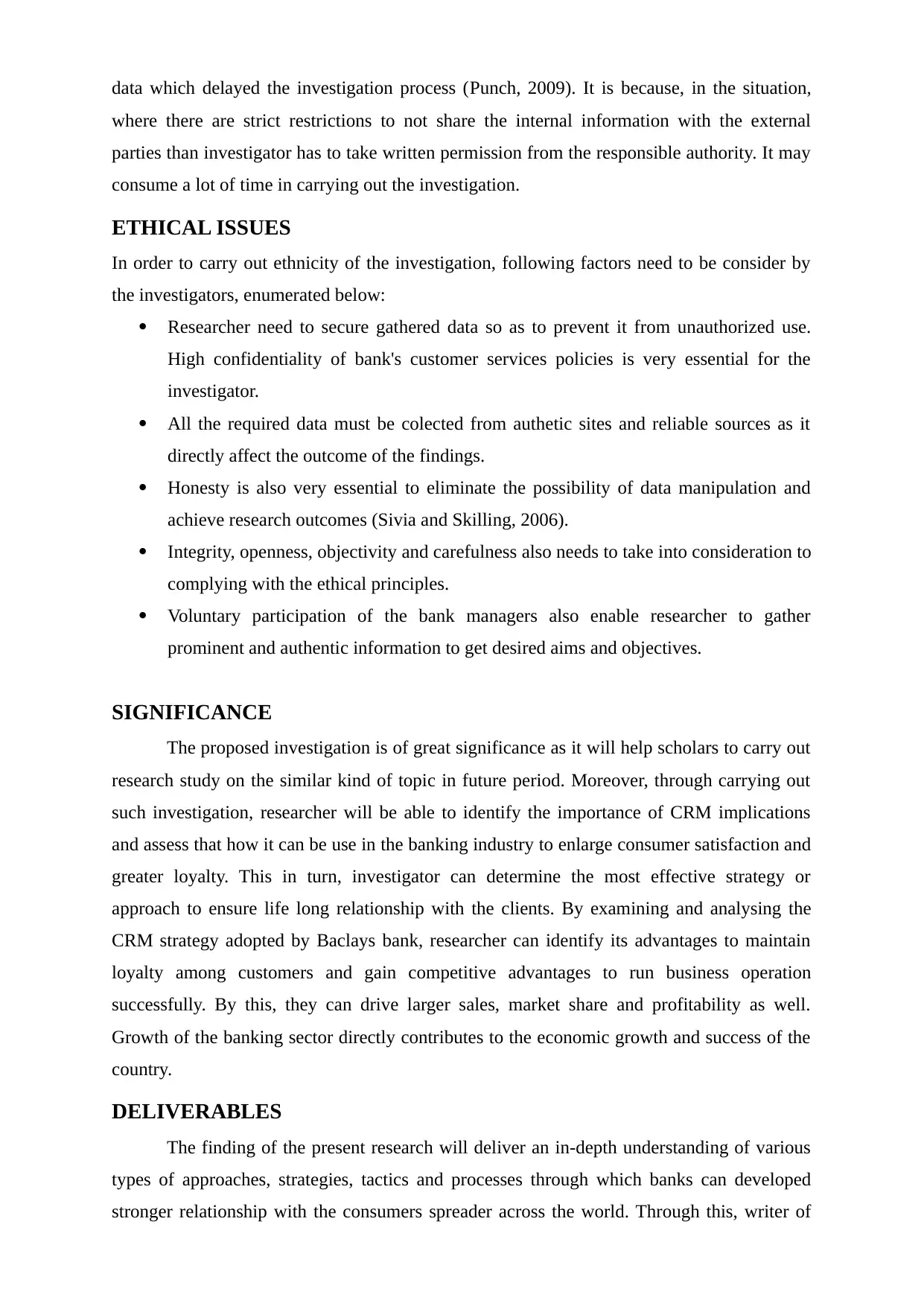
data which delayed the investigation process (Punch, 2009). It is because, in the situation,
where there are strict restrictions to not share the internal information with the external
parties than investigator has to take written permission from the responsible authority. It may
consume a lot of time in carrying out the investigation.
ETHICAL ISSUES
In order to carry out ethnicity of the investigation, following factors need to be consider by
the investigators, enumerated below:
Researcher need to secure gathered data so as to prevent it from unauthorized use.
High confidentiality of bank's customer services policies is very essential for the
investigator.
All the required data must be colected from authetic sites and reliable sources as it
directly affect the outcome of the findings.
Honesty is also very essential to eliminate the possibility of data manipulation and
achieve research outcomes (Sivia and Skilling, 2006).
Integrity, openness, objectivity and carefulness also needs to take into consideration to
complying with the ethical principles.
Voluntary participation of the bank managers also enable researcher to gather
prominent and authentic information to get desired aims and objectives.
SIGNIFICANCE
The proposed investigation is of great significance as it will help scholars to carry out
research study on the similar kind of topic in future period. Moreover, through carrying out
such investigation, researcher will be able to identify the importance of CRM implications
and assess that how it can be use in the banking industry to enlarge consumer satisfaction and
greater loyalty. This in turn, investigator can determine the most effective strategy or
approach to ensure life long relationship with the clients. By examining and analysing the
CRM strategy adopted by Baclays bank, researcher can identify its advantages to maintain
loyalty among customers and gain competitive advantages to run business operation
successfully. By this, they can drive larger sales, market share and profitability as well.
Growth of the banking sector directly contributes to the economic growth and success of the
country.
DELIVERABLES
The finding of the present research will deliver an in-depth understanding of various
types of approaches, strategies, tactics and processes through which banks can developed
stronger relationship with the consumers spreader across the world. Through this, writer of
where there are strict restrictions to not share the internal information with the external
parties than investigator has to take written permission from the responsible authority. It may
consume a lot of time in carrying out the investigation.
ETHICAL ISSUES
In order to carry out ethnicity of the investigation, following factors need to be consider by
the investigators, enumerated below:
Researcher need to secure gathered data so as to prevent it from unauthorized use.
High confidentiality of bank's customer services policies is very essential for the
investigator.
All the required data must be colected from authetic sites and reliable sources as it
directly affect the outcome of the findings.
Honesty is also very essential to eliminate the possibility of data manipulation and
achieve research outcomes (Sivia and Skilling, 2006).
Integrity, openness, objectivity and carefulness also needs to take into consideration to
complying with the ethical principles.
Voluntary participation of the bank managers also enable researcher to gather
prominent and authentic information to get desired aims and objectives.
SIGNIFICANCE
The proposed investigation is of great significance as it will help scholars to carry out
research study on the similar kind of topic in future period. Moreover, through carrying out
such investigation, researcher will be able to identify the importance of CRM implications
and assess that how it can be use in the banking industry to enlarge consumer satisfaction and
greater loyalty. This in turn, investigator can determine the most effective strategy or
approach to ensure life long relationship with the clients. By examining and analysing the
CRM strategy adopted by Baclays bank, researcher can identify its advantages to maintain
loyalty among customers and gain competitive advantages to run business operation
successfully. By this, they can drive larger sales, market share and profitability as well.
Growth of the banking sector directly contributes to the economic growth and success of the
country.
DELIVERABLES
The finding of the present research will deliver an in-depth understanding of various
types of approaches, strategies, tactics and processes through which banks can developed
stronger relationship with the consumers spreader across the world. Through this, writer of
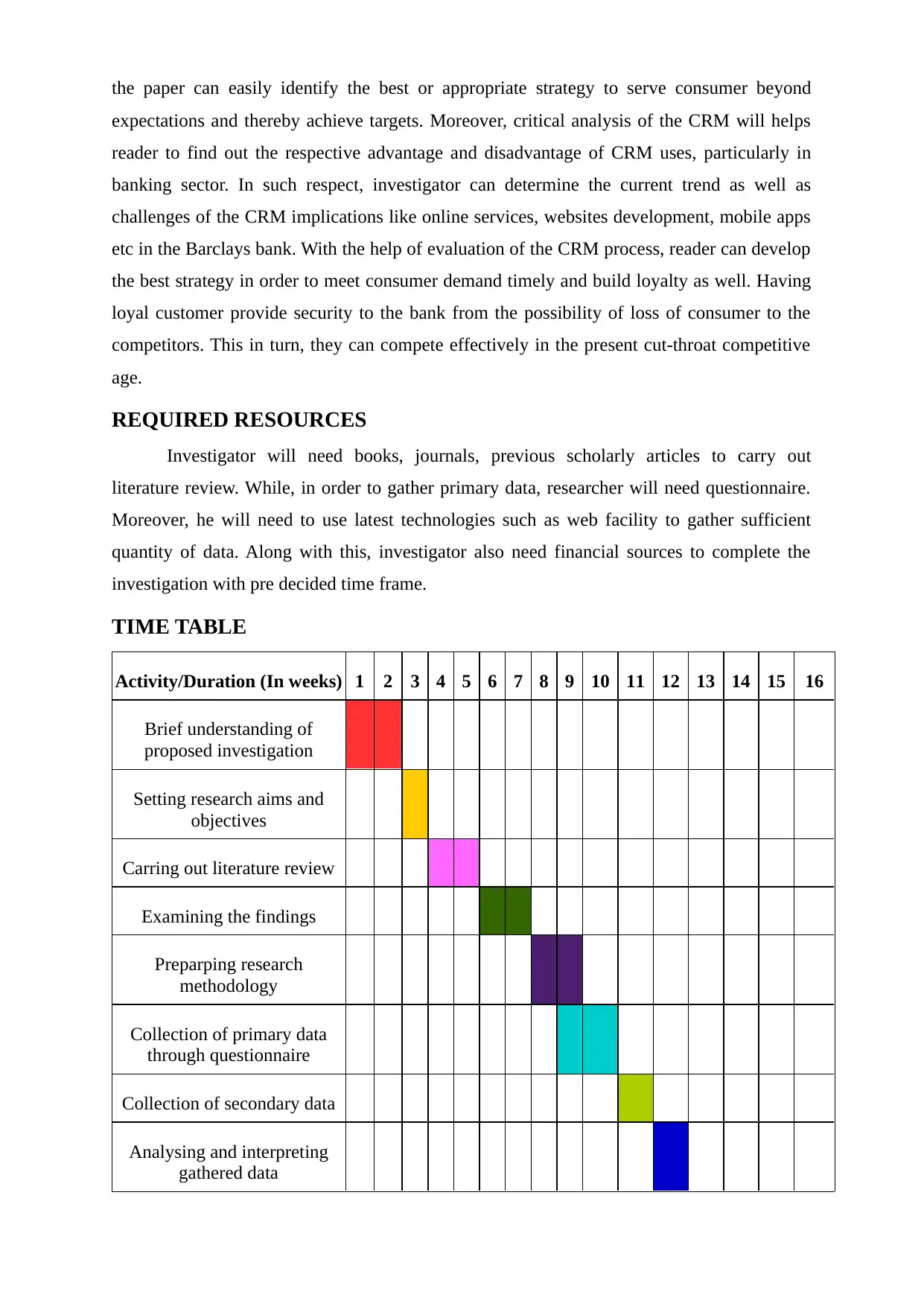
the paper can easily identify the best or appropriate strategy to serve consumer beyond
expectations and thereby achieve targets. Moreover, critical analysis of the CRM will helps
reader to find out the respective advantage and disadvantage of CRM uses, particularly in
banking sector. In such respect, investigator can determine the current trend as well as
challenges of the CRM implications like online services, websites development, mobile apps
etc in the Barclays bank. With the help of evaluation of the CRM process, reader can develop
the best strategy in order to meet consumer demand timely and build loyalty as well. Having
loyal customer provide security to the bank from the possibility of loss of consumer to the
competitors. This in turn, they can compete effectively in the present cut-throat competitive
age.
REQUIRED RESOURCES
Investigator will need books, journals, previous scholarly articles to carry out
literature review. While, in order to gather primary data, researcher will need questionnaire.
Moreover, he will need to use latest technologies such as web facility to gather sufficient
quantity of data. Along with this, investigator also need financial sources to complete the
investigation with pre decided time frame.
TIME TABLE
Activity/Duration (In weeks) 1 2 3 4 5 6 7 8 9 10 11 12 13 14 15 16
Brief understanding of
proposed investigation
Setting research aims and
objectives
Carring out literature review
Examining the findings
Preparping research
methodology
Collection of primary data
through questionnaire
Collection of secondary data
Analysing and interpreting
gathered data
expectations and thereby achieve targets. Moreover, critical analysis of the CRM will helps
reader to find out the respective advantage and disadvantage of CRM uses, particularly in
banking sector. In such respect, investigator can determine the current trend as well as
challenges of the CRM implications like online services, websites development, mobile apps
etc in the Barclays bank. With the help of evaluation of the CRM process, reader can develop
the best strategy in order to meet consumer demand timely and build loyalty as well. Having
loyal customer provide security to the bank from the possibility of loss of consumer to the
competitors. This in turn, they can compete effectively in the present cut-throat competitive
age.
REQUIRED RESOURCES
Investigator will need books, journals, previous scholarly articles to carry out
literature review. While, in order to gather primary data, researcher will need questionnaire.
Moreover, he will need to use latest technologies such as web facility to gather sufficient
quantity of data. Along with this, investigator also need financial sources to complete the
investigation with pre decided time frame.
TIME TABLE
Activity/Duration (In weeks) 1 2 3 4 5 6 7 8 9 10 11 12 13 14 15 16
Brief understanding of
proposed investigation
Setting research aims and
objectives
Carring out literature review
Examining the findings
Preparping research
methodology
Collection of primary data
through questionnaire
Collection of secondary data
Analysing and interpreting
gathered data
⊘ This is a preview!⊘
Do you want full access?
Subscribe today to unlock all pages.

Trusted by 1+ million students worldwide
1 out of 16
Related Documents
Your All-in-One AI-Powered Toolkit for Academic Success.
+13062052269
info@desklib.com
Available 24*7 on WhatsApp / Email
![[object Object]](/_next/static/media/star-bottom.7253800d.svg)
Unlock your academic potential
Copyright © 2020–2025 A2Z Services. All Rights Reserved. Developed and managed by ZUCOL.





